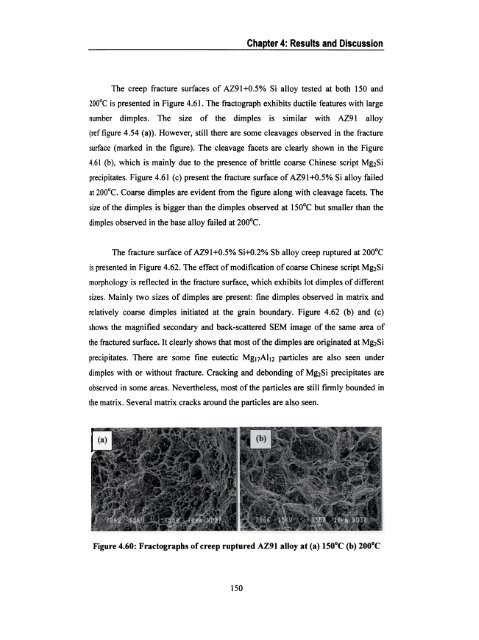“Influence of Si, Sb and Sr Additions on the Microstructure ...
“Influence of Si, Sb and Sr Additions on the Microstructure ...
“Influence of Si, Sb and Sr Additions on the Microstructure ...
You also want an ePaper? Increase the reach of your titles
YUMPU automatically turns print PDFs into web optimized ePapers that Google loves.
Chapter 4: Results <str<strong>on</strong>g>and</str<strong>on</strong>g> Discussi<strong>on</strong><br />
The creep fracture surfaces <str<strong>on</strong>g>of</str<strong>on</strong>g> AZ9l+0.5% <str<strong>on</strong>g>Si</str<strong>on</strong>g> alloy tested at both 150 <str<strong>on</strong>g>and</str<strong>on</strong>g><br />
200°C is presented in Figure 4.61. The fractograph exhibits ductile features with large<br />
number dimples. The size <str<strong>on</strong>g>of</str<strong>on</strong>g> <strong>the</strong> dimples is similar with AZ9l alloy<br />
(ref figure 4.54 (a)). However, still <strong>the</strong>re are some cleavages observed in <strong>the</strong> fracture<br />
surface (marked in <strong>the</strong> figure). The cleavage facets are clearly shown in <strong>the</strong> Figure<br />
4.61 (b), which is mainly due to <strong>the</strong> presence <str<strong>on</strong>g>of</str<strong>on</strong>g> brittle coarse Chinese script Mg;<str<strong>on</strong>g>Si</str<strong>on</strong>g><br />
precipitates. Figure 4.61 (c) present <strong>the</strong> fracture surface <str<strong>on</strong>g>of</str<strong>on</strong>g> AZ9l+O.5% <str<strong>on</strong>g>Si</str<strong>on</strong>g> alloy failed<br />
at 200°C. Coarse dimples are evident from <strong>the</strong> figure al<strong>on</strong>g with cleavage facets. The<br />
size <str<strong>on</strong>g>of</str<strong>on</strong>g> <strong>the</strong> dimples is bigger than <strong>the</strong> dimples observed at 150°C but smaller than <strong>the</strong><br />
O<br />
dimples observed in <strong>the</strong> base alloy failed at 200 C.<br />
The fracture surface <str<strong>on</strong>g>of</str<strong>on</strong>g> AZ9l+0.5% <str<strong>on</strong>g>Si</str<strong>on</strong>g>+0.2% <str<strong>on</strong>g>Sb</str<strong>on</strong>g> alloy creep ruptured at 200°C<br />
is presented in Figure 4.62. The effect <str<strong>on</strong>g>of</str<strong>on</strong>g> modificati<strong>on</strong> <str<strong>on</strong>g>of</str<strong>on</strong>g> coarse Chinese script Mg;<str<strong>on</strong>g>Si</str<strong>on</strong>g><br />
morphology is reflected in <strong>the</strong> fracture surface, which exhibits lot dimples <str<strong>on</strong>g>of</str<strong>on</strong>g> different<br />
sizes. Mainly two sizes <str<strong>on</strong>g>of</str<strong>on</strong>g> dimples are present: fine dimples observed in matrix <str<strong>on</strong>g>and</str<strong>on</strong>g><br />
relatively coarse dimples initiated at <strong>the</strong> grain boundary. Figure 4.62 (b) <str<strong>on</strong>g>and</str<strong>on</strong>g> (c)<br />
shows <strong>the</strong> magnified sec<strong>on</strong>dary <str<strong>on</strong>g>and</str<strong>on</strong>g> back-scattered SEM image <str<strong>on</strong>g>of</str<strong>on</strong>g> <strong>the</strong> same area <str<strong>on</strong>g>of</str<strong>on</strong>g><br />
<strong>the</strong> fractured surface. It clearly shows that most <str<strong>on</strong>g>of</str<strong>on</strong>g> <strong>the</strong> dimples are originated at Mg2<str<strong>on</strong>g>Si</str<strong>on</strong>g><br />
precipitates. There are some fine eutectic Mg11Al12 particles are also seen under<br />
dimples with or without fracture. Cracking <str<strong>on</strong>g>and</str<strong>on</strong>g> deb<strong>on</strong>ding <str<strong>on</strong>g>of</str<strong>on</strong>g> Mg2<str<strong>on</strong>g>Si</str<strong>on</strong>g> precipitates are<br />
observed in some areas. Never<strong>the</strong>less, most <str<strong>on</strong>g>of</str<strong>on</strong>g> <strong>the</strong> particles are still firmly bounded in<br />
<strong>the</strong> matrix. Several matrix cracks around <strong>the</strong> particles are also seen.<br />
Figure 4.60: Fractographs <str<strong>on</strong>g>of</str<strong>on</strong>g> creep ruptured AZ9l alloy at (a) 150°C (b) 200°C<br />
150
















